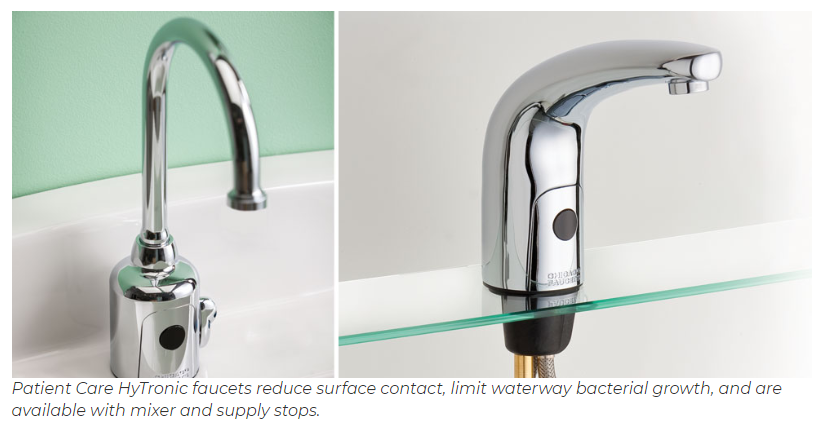
As businesses take their first cautious steps back to some sense of normalcy following the worst of the COVID-19 pandemic, facility managers will be responsible for re-opening buildings that may have been unoccupied for months.
One area of special concern is ensuring a safe supply of water. Stagnant water that has been sitting in pipes or other reservoirs within a building can be a breeding ground for disease-causing bacteria. Removing and managing stagnant water before and after re-opening should be a critical priority.
Risks of Stagnant Water
When buildings are temporarily shut down or normal usage is scaled back significantly, regular water flow is either halted or heavily reduced. This can increase the presence of stagnant water in the plumbing system that must be removed before normal water usage and building occupancy can resume safely.
According to the Centers for Disease Control and Prevention (CDC), “the temporary shutdown or reduced operation of a building and reductions in normal water use can create hazards for returning occupants.”
Although the CDC highlights Legionella as a key concern, the organization warns that other microbial hazards, changes in water chemistry, leaching of lead and metals, disinfection by-products, and sewer gases can also be dangerous.
Options for Removal
 Facility managers should have an established water management plan to follow during re-opening procedures. One component of this plan should be removing all stagnant water from a building.
Facility managers should have an established water management plan to follow during re-opening procedures. One component of this plan should be removing all stagnant water from a building.
The CDC recommends flushing hot and cold water through all points of use. “Flushing may need to occur in segments due to facility size and water pressure,” according to a CDC document. “The purpose of building flushing is to replace all water inside building piping with fresh water.”
Hot water should be flushed at its maximum temperature, and other water-related equipment such as ice machines, fountains, and refrigeration systems may require special care and cleaning.
Touchless Faucets for Better Hygiene
Once you have flushed stagnant water completely out of your water supply piping, it’s important to make sure other parts of your plumbing system — specifically faucets and other water dispensers — are helping promote good hygiene as much as possible. One way to do that is by installing touchless faucets and fixtures.
For example, Chicago Faucets offers a touchless HyTronic® faucet for Patient Care Applications, which can be pre-programmed to help health care workers and others follow the hand-washing recommendations outlined by the CDC.
Touchless faucets can provide improved convenience and hygiene in public restrooms to keep visitors safe. Many models take into consideration the special requirements of faucets in commercial buildings, keeping all electronic components above the deck for easy installation and easy access during routine maintenance.
In addition to regularly flushing stagnant water out of a building’s supply system, it’s important that distribution points such as faucets maintain a safe water quality level. A study conducted by the University of Pittsburgh under the guidance of Special Pathogens Laboratory and funded by Chicago Faucets, examined the level of pathogens present in both manual and touchless faucets. The study showed that both types of faucets had the potential to harbor Legionella bacteria.

In response to these findings, Chicago Faucets developed HyTronic faucets for Patient Care Applications. HyTronic for Patient Care is designed and constructed to limit the tested microbial contamination to a level statistically similar to standards set by a conventional manual faucet, while providing the hygiene benefits of touch-free operation. In addition, all Chicago Faucets HyTronic and E-Tronic® faucets, including our E-Tronic 80 Series restroom faucets, can be programmed for an automatic hygiene flush that prevents stagnant water from collecting in the faucet and supply piping.
Faucet Programming with Commander™
Chicago Faucets also offers the Commander handheld programming unit, which allows facility managers to keep close tabs on a building’s water usage and activate special faucet modes, including the hygiene flush feature. Commander allows you to change settings quickly and easily on your Chicago Faucets HyTronic and E-Tronic products. Facility managers can scan and retrieve data, modify settings, and use diagnostic tools to manage all Chicago Faucets electronic fittings from one device.
How to Maintain Water Quality During Periods of Low or No Use
 Once you have ensured that your water quality is at a safe level, and you’re ready to re-open your building, be sure you have protocols in place for ongoing maintenance.
Once you have ensured that your water quality is at a safe level, and you’re ready to re-open your building, be sure you have protocols in place for ongoing maintenance.
Keep lines of communication open with your local water utility to stay informed about water supply disruptions. Implement a maintenance program that regularly checks water temperature, pH level, and disinfectant standards. Implement and document your water management protocol so you can respond quickly to any potential water-related issues. Installing touchless faucets with automatic hygiene flush will provide additional protection at the actual point of water usage, helping to keep employees and guests healthy and safe.
.png)

